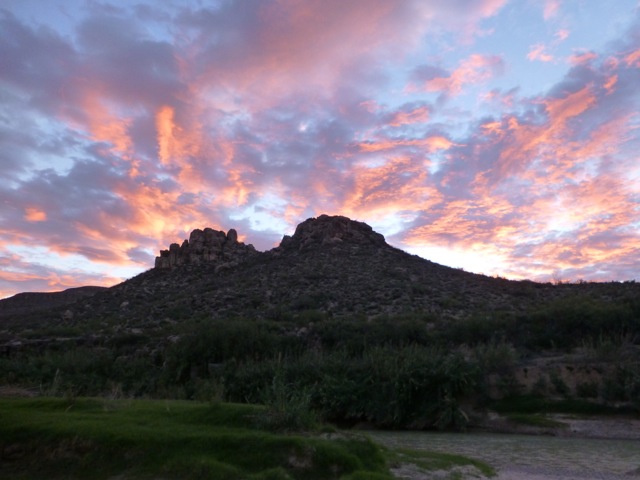Canyon Snapshots: Of Suns and Moons Long Past
|
|
(This is the fourth vignette from 8 days on the Lower Canyons of the Rio Grande in Texas in early November. I was one of 11 expertly guided by Burt Kornegay. We paddled 6 fully loaded canoes 90 miles, gathered around open fires, and ate and slept out under the stars (or cold, drizzling clouds).

Caption: The sun petro glyph from Temple Canyon. Photo by Burt Kornegay, modified.
A side trek into Temple Canyon took us to a silted-up cliff side decorated with several petro glyphs etchings. While a few years back these were at shoulder height (according to Burt) the carvings were now at knee level; we had to stoop to see them up-close. The river-in-flood moves tons of sand and rocks, as always, grinding down, smoothing, filling, emptying, releasing. Nothing remains the same.
The sun petro glyph could be 10,000 years old or maybe 5,000. Old, for sure. Someone, man or woman, pecked away at the stone, cupping out the rock (a three-inch diameter or so), and then abraded at least 6 rays (or petals, if this was meant to be a flower).
People lived in these canyons; the evidence includes their art and tools, cave shelters and perfectly round grinding holes some a foot deep - in which pestles pounded and ground seed into flour.
As our group turned and headed back to the canoes, I gently touched the sun, in farewell, and felt a warm connection to the carver, a kinship.
Why carve a sun - if that is what it is - into a stone face? In a desert? Unanswered questions link us across the ages: Who are we? Why are we here? And, why do we stop in our pursuit of survival, to make art?
I write this on Christmas Eve, only a few days removed from the Winter Solstice. For me the stone sun is like the sun in my native country, Latvia. There the Summer Solstice has been celebrated for millennia with pagan gusto over several days, a human yearning - indeed prayer - in tune with Nature.

Caption: Sunset in the Lower Canyons.
Leading from the Middle Library of the week: Uniwersytet Mikolaja Kopernika Torun, 87-100 Poland
UMK Library
Copyright John Lubans 2013

Caption: The sun petro glyph from Temple Canyon. Photo by Burt Kornegay, modified.
A side trek into Temple Canyon took us to a silted-up cliff side decorated with several petro glyphs etchings. While a few years back these were at shoulder height (according to Burt) the carvings were now at knee level; we had to stoop to see them up-close. The river-in-flood moves tons of sand and rocks, as always, grinding down, smoothing, filling, emptying, releasing. Nothing remains the same.
The sun petro glyph could be 10,000 years old or maybe 5,000. Old, for sure. Someone, man or woman, pecked away at the stone, cupping out the rock (a three-inch diameter or so), and then abraded at least 6 rays (or petals, if this was meant to be a flower).
People lived in these canyons; the evidence includes their art and tools, cave shelters and perfectly round grinding holes some a foot deep - in which pestles pounded and ground seed into flour.
As our group turned and headed back to the canoes, I gently touched the sun, in farewell, and felt a warm connection to the carver, a kinship.
Why carve a sun - if that is what it is - into a stone face? In a desert? Unanswered questions link us across the ages: Who are we? Why are we here? And, why do we stop in our pursuit of survival, to make art?
I write this on Christmas Eve, only a few days removed from the Winter Solstice. For me the stone sun is like the sun in my native country, Latvia. There the Summer Solstice has been celebrated for millennia with pagan gusto over several days, a human yearning - indeed prayer - in tune with Nature.

Caption: Sunset in the Lower Canyons.
Leading from the Middle Library of the week: Uniwersytet Mikolaja Kopernika Torun, 87-100 Poland
UMK Library
Copyright John Lubans 2013
 John Lubans - portrait by WSJ
John Lubans - portrait by WSJ